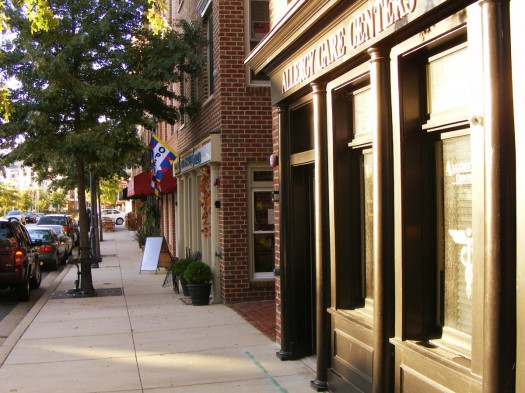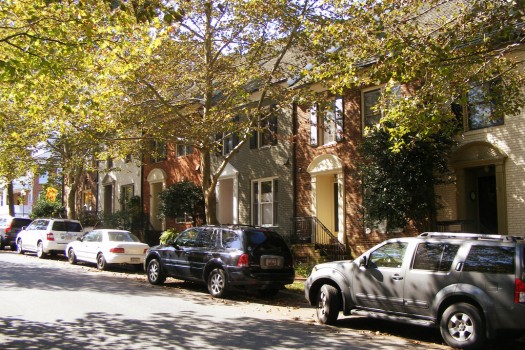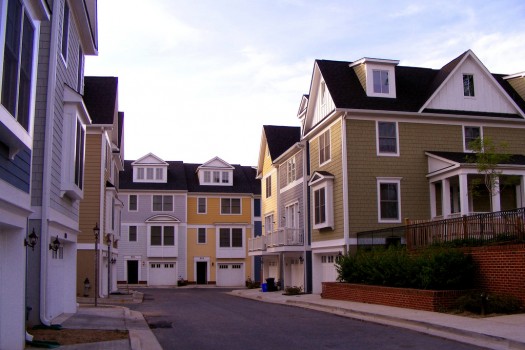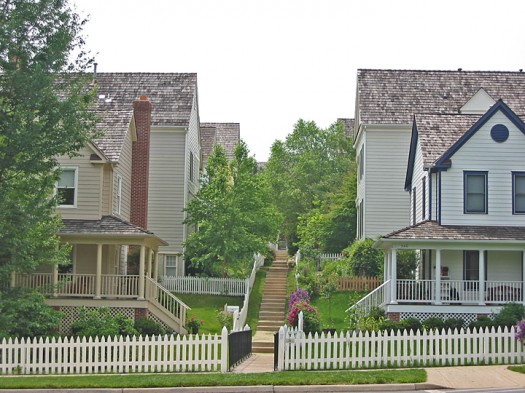A Placemaking Journal
Serving the Needs of Seniors: Solutions in practice
Last month we talked about Connections, Community, and the Science of Loneliness, in which I lamented my parents’ generation lack of active communities geared toward people of all ages. Since then, I’ve looked a little more deeply into some of the newer neighborhoods designed around livability, to see which of them are offering especially graceful aging options.
My partner Ben Brown has pointed out that nothing in our $51 billion dollar age-segregated housing market provides quality of life that matches dwelling among our extended families. What if that market offered smaller homes — like cottages, condos, and row houses — within walking distance to both daily needs and larger family homes? Within walking distance from kids and grandkids? The most successful age-segregated housing taps into nearby communities, whether historic neighborhood centres, or newer mixed-use developments. Co-housing and multigenerational communities are advanced solutions.
Accessibility for seniors — with the addition of some universal design interior features — has the same requirements for just about everybody: walkable proximity to daily needs and transit.
Still, with my own parents in mind, I’ve been looking at some places that have been taking supportive aging to the next step. For those unfortunate situations when independent living just isn’t an option anymore, no matter how livable and convenient.
In these instances where people require assisted living, the levels of isolation are significantly different based on how far removed the care facility is from the heart of town. My parents are one mile from their town square, but at this point in life, that means it’s completely inaccessible unless a family member is available to drive.
When you can only walk one block, suddenly connectivity matters. A lot.


larger footprints more likely to be home to extended family. Image credit Flickr user Dan Reed.


Kentlands, Gaithersburg, Maryland
I asked my friend, Diane Dorney, Kentlands resident and Executive Director of the Seaside Institute, to tell me what some of these solutions are in her town. While Kentlands offers up a wide variety of housing types within an easy walk to daily needs, it also offers a senior housing component called Kentlands Manor. The Manor is in the heart of downtown, so people living there can walk to lots of shops, restaurants, and a movie theatre. The building is right across the street from Whole Foods, a Giant Foods with a pharmacy, and a short walk from the medical clinic on Main Street.
Many Kentlands families have parents in Kentlands Manor where they and their children can visit easily — a rather ideal situation. Being this accessible to the community makes connections more likely, such as the weekly book club night at Kentlands Manor.
The negative side of senior living in Kentlands is that it was built before there was an emphasis on master-down living. Most are house plans with no bedrooms on the first floor, something that’s changing in newer communities. Otherwise, if you can make the stairs easily, a majority of homes in Kentlands support senior living because of the accessible downtown and a bus service that links the community to the Metro, on to Washington D.C., and any number of places along the Red Line.
But what about Continuous Care Retirement Communities (CCRCs) fully integrated into walkable town centres so seamlessly that you don’t realize they’re there? Other than the increase of elders playing checkers on the town square.
With Baby Boomers headed into their retirement years and determined to redefine what it means to be old, the “active adult” and assisting living segments of the senior housing industry are debating the design of future communities. There’s a clear move among Boomers away from seniors-only complexes disconnected from multigenerational neighborhoods and urban centers.
CCRCs — offering several tiers of graduated accommodations from independent living to around-the-clock care — came of age in the context of suburban greenfield development. The move away from such segregated retirement islands and the rising costs of health care for the full-care component of CCRCs are pressuring the industry to rethink the business model. Many believe the future will combine the expertise of medical care managers with the advantages of TND design like the Kentlands so that these facilities can be integrated more fully into communities. That way, they share the costs and advantages of amenities such as shopping within walking distance, health and fitness centers, and performing arts and entertainment complexes.
This sort of community design manages to accommodate the full range of resident needs through all stages of life and amortizes costs for premium facilities over time and through multiple partnership arrangements. And it will set a new standard for community planning in the age of Boomer retirement.

Consider this a call for developers who are interested in developing this model for a very clear market demand and exceptional value capture.
In the mean time, here is a range of other senior living solutions that have been embedded in Traditional Neighborhood Developments. I haven’t toured most of these myself, so can’t speak to the level of livability achieved. Have one I don’t know about? Please let me know in the comments below.
Middleton Glen at Middleton Hills, Middleton, WI. Middleton Glen is an independent living community located in Middleton Hills, Wisconsin, a TND designed by DPZ plan with Prairie School architecture.
The Stratford at WestClay, Carmel, Indiana. The Stratford is an upscale retirement community located within The Village of WestClay.
Legacy Senior Residences at Norton Commons, Louisville, Kentucky. Legacy Senior Residences are 24 units above retail with apartment rents that start around $450 per month. Aimed at the 55 and over crowd with limited financial resources, these flats are a short walk from the shops and civic spaces of Norton Commons, a TND designed by DPZ plan with a PlaceMakers architectural design guidelines. The newly opened YMCA has many seniors related programs that support healthy aging in place. Several multi-generational families live at Norton Commons, including the developer, David Tomes, along with his kids and grandkids. He tells me, “It sounds old fashioned, but it is the way we used to live, where generations could care for each other. Grandparents can look after grand kids –and vice versa!”
Wild Sage and Silver Sage Village at Holiday, Boulder, Colorado. Holiday, 10 minutes from downtown Boulder, is a ten-year-old New Urbanist development built on an old drive-in movie site. Five local developers, 300 units, 40% affordabile. The retail and offices fronting Broadway, live-works, town houses, duplexes, and single family units of different scales deeper within the project are familiar to most urbanists. What sets it apart are its two cohousing neighborhoods: Wild Sage, 34-unit multi-generational neighborhood and Silver Sage Village, 16-unit elder cohousing cluster.
The Cascades at Verde, Greenville, SC. The Cascades is the largest CCRC in South Carolina, a cornerstone of the mixed-use Verde.
The Summit, Wyndhurst, VA. The Summit is a CCRC within Wyndhurst.
Town Commons Howell, MI. Town Commons is a mixture of single-family homes, townhouses, apartments, a senior assisted-living facility, neighborhood retail.
Franklin Park, North Richland Hills, TX. Franklin Park is an assisted living facility at Home Town TND.
Pointe West, Vero Beach, FL. Pointe West TND includes a retirement area with single-family units and multi-purpose facilities.
ElderSpirit in Abingdon, VA. ElderSpririt is a mixed-income, co-housing neighborhood a short walk from the historic town center of Abingdon. Ben Brown has written about this community of “Former nuns with the focus and organizational skill of Navy Seals” dedicated to placemaking for seniors, which sounds rather inspirational.
“We design our cities so that the old and the young are completely helpless. Why? Because they can’t drive.” ~Andres Duany
And that design is “an architecture of endemic loneliness” … “pitting our need for independence against our need for community,” according to Atlantic Cities. Perhaps we’ll get some breakthroughs from American Society on Aging’s annual conference, this Tuesday through Saturday in Chicago. And at CNU 21: Living Community in Salt Lake City in May. And from the new book, Aging in Community Revised Edition, by Janice Blanchard, with a chapter from Ben Brown on alternatives to standard retirement communities. And from our own placemaking together here.
–Hazel Borys
If PlaceShakers is our soapbox, our Facebook page is where we step down, grab a drink and enjoy a little conversation. Looking for a heads-up on the latest community-building news and perspective from around the web? Click through and “Like” us and we’ll keep you in the loop.









